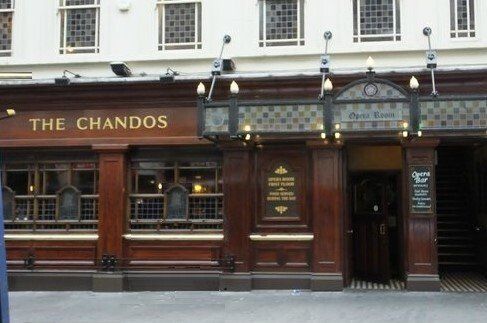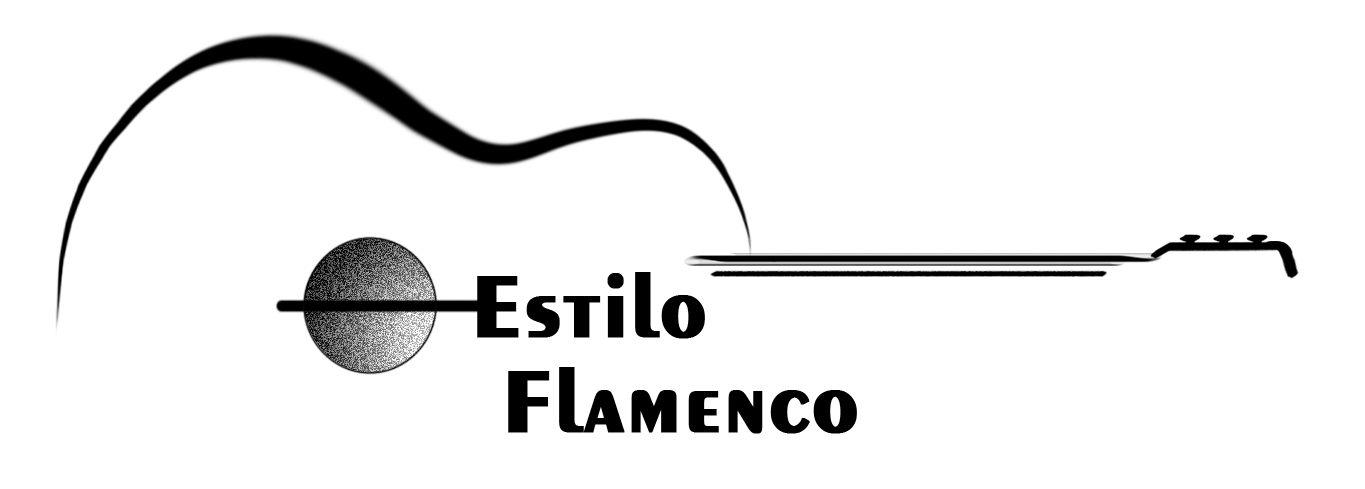
A Life Dedicated to Flamenco Guitar
A Journey through my Flamenco Guitar Adventures.

Click-index to Chapters
- Early Years
- Tony Clinton Snr
- My First Lessons
- George Clinton
- Chandos Bar, My First Solo Job, Peña Flamenca de Londres etc.
- Cordoba
- Rotterdam Conservatory
- Back in London
- The 1990s
- The 2000s
- The 2010s etc
Early Years
My flamenco guitar journey started when I was born in 1965 in North London to a Spanish mother and English father, namely Josefina and Tony Clinton (my mother's maiden name was Castro Cano). I say my journey began when I was born because I was lucky enough that my dad was a flamenco guitarist and so I grew up listening to flamenco - even if I didn't realize just how lucky I was at the time! I was christened Franz Antony (actually my dad's real name also) which I much later changed to the Spanish version Francisco Antonio. I still use Franz Antony for my non-flamenco exploits, which include writing about my other passion, namely classic films and TV — my first book,
British Thrillers - 1950-1979 was published in the US in late 2020 (preview available here). For all my childhood, I was known as Tony Clinton (Jnr).
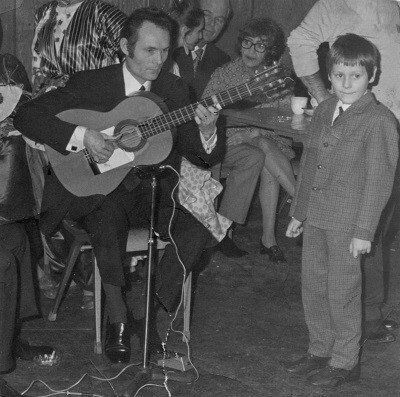
Me (age 4 or 5) with my dad at one of the end-of-year dance class shows.
Tony Clinton Snr
My dad, Tony Clinton Snr, had started playing in the 1950s and was one of the first Englishmen to play flamenco really well. He was amazing as he had taught himself everything from listening to records in the days when one had to slow down LPs from 33 rpm to 16 rpm in order to better hear the notes (I would also have many years of doing the same). He had loads of students when I was growing up and also played for classes and shows - it was incredible how much time he was able to devote to the guitar given that he always held a career with a day job. The student I remember the most, and one who would become a very important figure in flamenco as both a guitarist and journalist, is Marcos (more about him here). Marcos studied with my dad from around 1967/8 (aged 11) to around 1976; towards the end they were playing as a duo — "Antonio y Marcos" — including a series of concerts at the Edinburgh Festival in '76. (Click here to hear a rare radio spot of them playing a Zambra Gitana to promote that.) Around 1966, my dad took over accompanying a Spanish dance class from one of his students, Berta Chamberlain, who herself had a young student — none other than Ian Davies, then around 11 years old. Ian would go
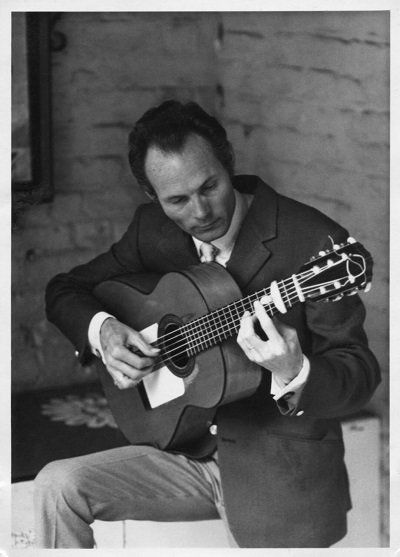
My dad, Tony Clinton, in the 1960s.

My dad with his student Marcos (c. 1969). Photo appeared in Guitar International magazine, September 1991 (in the interview with Marcos).
on to give a concert at the Purcell Room at age 15 and then on to a great career in Spain playing with, among others, the legendary Victor Monge "Serra-nito" (more about Ian Davies here). The dance classes were run by a lady named Lucille Armstrong, who taught a varied repertoire that was comprised of not only flamenco but also of traditional Spanish regional and folk dances — there was everything from alegrias, farruca, fandangos, Sevillanas and bulerias to Jota Ara-
gonesa, El Vito, Panaderos, Verdiales and loads more. Most of the dances were accompanied by a specific set melodic arrangement for guitar. The young Ian Davies, who'd already been taught some of my dad's material via the aforementioned Berta Chamberlain, had also been sitting in at the class with her, and continued to do so for a while after my dad took it over. (The classes were held in the evenings at George Eliot primary school in St. John's Wood, London, next to Quintin Kynaston where Ian Davies was a student.) At a very young age, my sister and I would go along to the end-of-term/year class parties (basically just running around and causing havoc) and my sister eventually joined the class to dance while also being taught how to play flamenco by our dad. At age 10, she was already able to play — extremely competently — arrangements of farruca, alegrias, bulerias, soleares, rumba, Sevillanas, fandangos and, well, pretty much everything. She was a natural with the guitar and it's a shame she eventually lost interest during her early teens. One thing she used to do that was particularly frustrating to my dad's students: she would listen to the lesson from outside, and afterwards, as the student was preparing to leave, would play what they'd just learned. Often, the student would say something like "wow, she knows that piece" to which my dad would reply — and this was true — that she had not actually ever learned it, but just picked it up from listening outside the door. That was a talent for sure!
My First Lessons
My very first guitar lesson was actually at age eight and from my sister, who thought it would be fun if our dad came home from work one day to find me playing a Sevillanas. I learned the Sevillanas, my dad was surprised, and I subsequently didn't touch a guitar again until age 12 in 1977. By this time my sister had stopped playing and dancing, and I took up the guitar. I wasn't actually that interested at the time, although it was a good way to spend more time with my dad. As I was so familiar with flamenco guitar music, learning and remembering it was fairly easy, although it was the technique I initially had difficulty with and my dad did not focus too much on breaking down the techniques. I remember with the first few chords I had to position my left-hand fingers with my right hand before strumming a chord! Anyhow, quite soon I was sitting in with my dad at the dance classes of Lucille, two of whose students — a lovely Spanish couple called José and Olga Osa — eventually took it over, adding a few new strictly flamenco dances but also keeping the regional/folk dances. I would later understand how fortunate I was to have had the opportunity to play for this class and learn all those pieces, which gave me a much wider understanding of Spanish music than had it been just a straightforward flamenco class of the type I would later play for in abundance.
By 1980, aged 14, my dad had taught me loads of flamenco material which I just played without really fully understanding the structures of the various forms; I was basically able to remember this material with no problem from having heard so much while growing up, but there was never much focus on how the different "palos" (flamenco forms) were structured. I just did as my dad directed. I was recently surprised at just how much material I did learn at that time when my dad sent me some old home-recorded cassettes from 1979/1980 of us playing duets. There was everything from tanguillos, garrotin, alegrias, several bulerias (including with specific tunes such as "Puentecito"), farruca, zambra, fandangos de Huelva, Sevillanas, Malagueñas y Verdiales etc. The cassettes were in a poor state but I managed to rescue most of the material, and some of the tracks can be heard at the following links (you can hear I used to bite my nails from the picado, particularly on the second bulerias where I was given the main part to play):
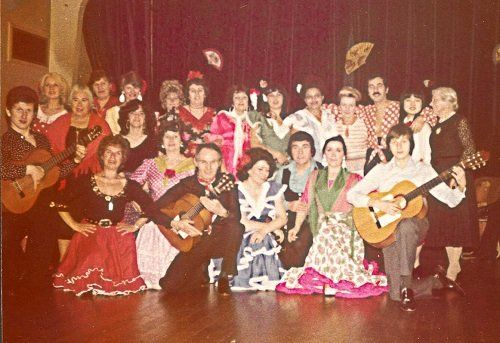

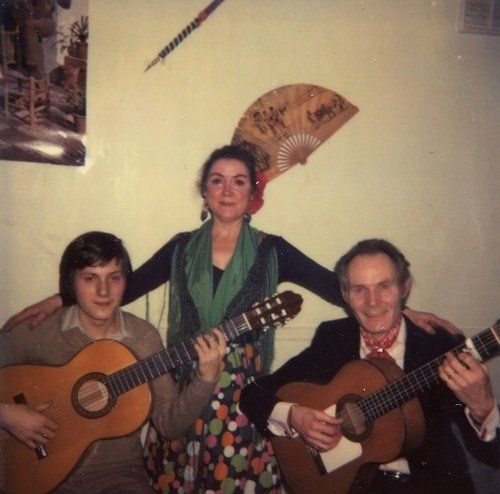
Above Left
End-of-term class party (c. 1980). On the far right (next to me) is Lucille Armstrong, teacher at the class until it was taken over around that time by two of the participants — Spanish couple Olga and Jose Osa (on my right). My dad's in the middle and at far left is one of his students Philip Blackall, a great guy who used to regularly sit in on the class and who was later known on the UK flamenco circuit as Felipe "Rompesillas" (sadly no longer with us).
Above Right
The same party with my dad and Felipe.
Left
End-of-term class party (February 1982). Me at 16 with my dad and class teacher Olga Osa.
The dance classes were great fun and were held on Mondays, Wednesdays and Fridays with different levels, and my dad also held a guitar class on Tuesday evenings which I would also go along to. I never really practiced at all — my playing mostly consisted of playing pieces with my dad at home and at the classes. There were two things that led to me becoming more independent guitar-wise during the very early 1980s. However, before going into those, I'd like to spend a bit of time on my uncle George, who was a classical guitar player but even more significantly an extraordinary guitar journalist who founded the magazine Guitar (later known as Guitar International).
George Clinton
(1931-1991)
Although I only ever played fla-menco, I was always informed about other styles of guitar thanks to my uncle George Clinton (my dad's brother), editor and founder of the magazine
Guitar (later known as
Guitar International). George had star-ted out by playing flamenco in the 1950s with my dad before focusing on classical guitar. Prior to founding
Guitar, George's writings about the instrument included crafting letters and journalistic contributions for the magazine
B.M.G. One of these contributions was the "Cover Artist" article about Juan Teijeiro, later famous for his "London Guitar Studio."
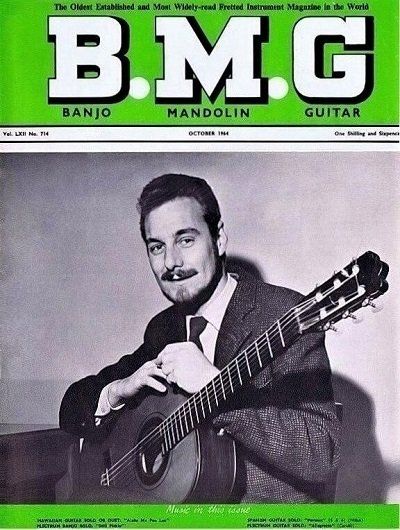
My uncle George on the cover of B.M.G. (October 1964)
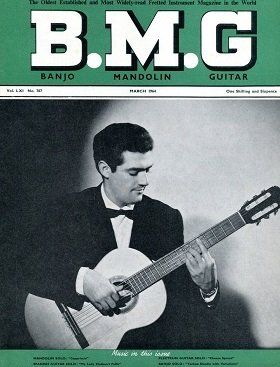
Above: Juan Teijeiro on the cover of the March 1964 issue of B.M.G. magazine. (Juan would later found the Juan Teijeiro Music Company and the famous Lon-don Guitar Studio, frequented by the world's top guitarists.) Click here to view PDF of the magazine's "cover artist" article written by George Clinton
The first issue of George's
Guitar magazine was dated August 1972 and featured John Williams on the cover with the quote "I'd be bloody awful with a group." (John would later be part of the group Sky and it wasn't awful at all.) The magazine covered many styles of guitar — classical, flamenco, rock, folk, blues, jazz, ragtime — even though George's main interest was classical. The subtitle for this first issue was "The Journal of Britain's Guitarists". This very quickly changed with issue #2 (Paco Peña cover) to "The Magazine for all Guitarists". As of November 1983, there were a few issues with no subtitle at all until the title was changed to
Guitar International in August 1984. With the November 1984 issue,
Guitar International adopted the subtitle "Britain's No.1 Classical Guitar Monthly", reflecting the magazine's growing classical content. In late 1986, the subtitle became "For Classical Guitarists Around the World". As of June 1989, with the magazine starting to gear back towards more diverse content, the use of a subtitle was once again dropped (just "Guitar International") until August 1990, whereupon it was reintroduced as "For Fingerstyle Players Around the World", this quickly followed as of October of the same year by "For Acoustic Fingerstyle Players" which lasted
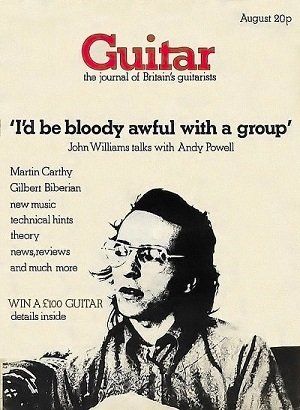
First issue of George's Guitar magazine with John Williams on the cover (August 1972)
until the final issue dated February 1992. I remember discussing this last change of subtitle with George (I'd recently had some teaching material published in the magazine) and playing around with several words including "acoustic" which is what was ultimately decided upon.
George was also an excellent photographer and took many of the photos used for the magazine's interior as well as for some of the covers. He photographed many of the greats including from the classical world — Segovia, John Williams and Julian Bream — to the flamenco world — Sabicas and Paco de Lucia — and was actually a very close friend of Segovia and frequently went to stay at the legendary player's home in Spain. In 1977, while the magazine was in full swing, George produced the book
Andrés Segovia,
a collection of writings and photos about the maestro published by George's Musical New Services (as was the magazine).
Click here to view PDF of one of the magazine's adverts for the book which includes some very nice words by Segovia about George. (To view PDF of an ad for another of George's books,
click here.
Below are some of George's photos. The one of Segovia was taken at the Alhambra, Granada in 1976 and was used for the cover of the magazine's January 1983 issue — a "Segovia 90th Birthday Souvenir Issue" — which also included a print of the photo as a free giveaway (Click here to view PDF of the giveaway photo print). The photo of Sabicas was used for the cover of the August 1982 issue, and featured in the interior of at least one other issue. The picture of Paco de Lucia and his brother Ramón de Algeciras is as it appeared in the March 1990 issue, and was edited from the original photo in which Juan Martin also appeared.

Segovia

Sabicas

Paco de Lucia and Ramón de Algeciras
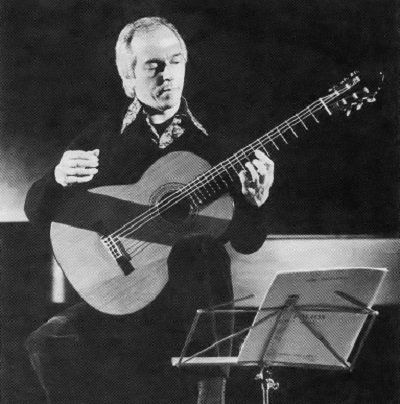
John Williams
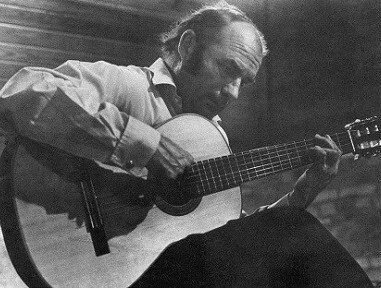
Julian Bream
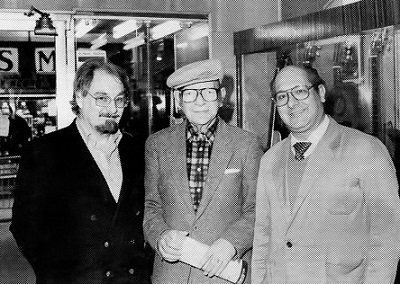
George, left, with Sabicas and renowned luthier Manuel Rodriguez (Madrid 1984)
George could be described a a force of nature, driven by impulse and instinct in his desire to ensure that the guitar in all its forms got the respect it deserved. Remembered by some as a difficult man, he took no prisoners when it came to argument and debate, and one could hope not to get on his wrong side as this could easily lead to a strongly-worded thrashing — so to speak — via his magazine. Indeed, one of George's more controversial editorials was in the December 1985 issue, and was devoted entirely to a counter-attack on Colin Cooper — by then editor of Classical Guitar magazine, and who'd been a teaching assistant to George in the early 1970s as well as a partner in the setting up of Guitar — in connection with their views on flamenco guitarist Juan Martin. The editorial in question is headed by a cut-and-paste photo job depicting Mr. Cooper with his hands at my uncle's throat (Click here to view PDF).
My own personal favourite issue of Guitar magazine is the classic April 1976 issue with Paco de Lucia on the cover. This is partly because it was around the time of his London concert debut at the Wigmore Hall, which I was lucky enough to be able to attend; I was 10 years old and wasn't playing yet so don't remember too much about the concert, but do remember how nice Paco was to my sister and I when we went backstage to meet him and get his autograph. The concert was pretty much the same as the famous Madrid Teatro Real concert (Paco playing mainly solo with some pieces accompanied by his brother Ramon de Algeciras) and created enormous interest among the guitar scene (all genres). The general public were becoming aware of Paco through some radio play of his rumba "Entre dos Aguas", specifically a new souped-up version which he'd recorded for the 1975 Island Records release — called just Paco — of his album Fuente y Caudal ("Entre dos Aguas" was the only re-recorded piece). The new version is referred to in an interview in the magazine conducted by Ray Mitchell, who later wrote the sleeve notes for the 1977 Island release of Paco's album, Almoraima. The interview is great, touching on things which I haven't seen in other interviews, and is another reason this particular issue is my favourite (click here for PDF of the interview).

Guitar, April 1976 (classic issue featuring Paco de Lucia)
The magazine's days were pretty much over after George's sad and untimely death in October of 1991. (The publication limped along — with lots of reprint material — for a few issues until February 1992 under the editorship of George's son Geoff [my cousin] who had previously been in charge of sales and marketing.) George's character and approach to his work was very well summed up in an obituary by his friend and colleague Lance Bosman that appeared in the December 1991 issue (click here to view PDF of the obituary).
Chandos Bar, My First Solo Job, Peña Flamenca de Londres etc.
Sometime around early 1981, at age 15, I went with my dad to a Central London pub called The Chandos, the basement bar of which — also known as The Chandos — operated as a flamenco bar and had a resident flamenco guitarist most nights of the week. The main Chandos pub (still going) is on the corner of St. Martin's and William IV Street, with the entrance to the basement flamenco bar (sadly no longer there) on William IV Street. There was a 20-something Spanish guitarist called Pepe there at the time who played and sang mainly rumbas, but who also knew how to play all the main flamenco styles and so performed bulerias, alegrias, tangos, solea etc. He was particularly into the flamenco guitarist and singer-songwriter Manzanita (a huge hit in Spain at that time) and sang many songs from his then recent
album, the fantastic Poco Ruido y Mucho Duende. I dared to ask Pepe if he would let me play on his guitar and he very kindly did! I played some bulerias which he praised before then inviting me to sit in with him one night per week. This was a fantastic new learning opportunity and very different to what I had been doing for the past three years, and was the start of me gaining some independence in my play-
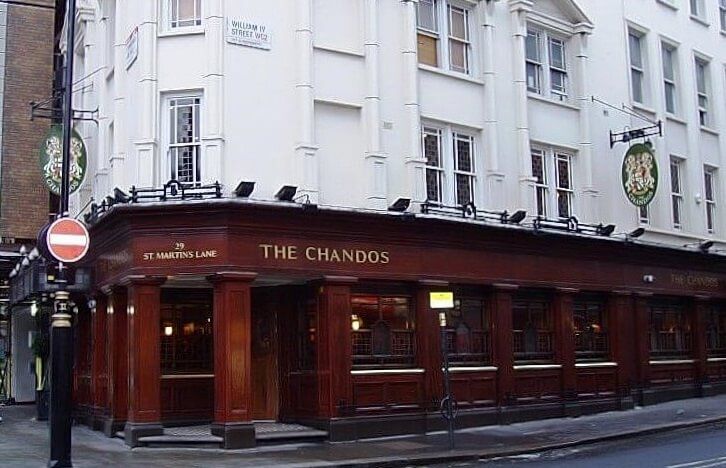
The Chandos pub, once home to legendary flamenco bar

Classic Manzanita album Poco Ruido y Mucho Duende
ing. I was soon excitedly looking forward to Tuesday nights, which was the night we agreed I would sit in. Over the weeks, I would diligently accompany Pepe, and was rewarded further by him occasionally turning to me during the playing to say "you play a falseta now" in a bulerias, or "you have a go" — meaning that I should play a solo during "Entre dos Aguas" or some other rumba. It was a fantastic time musically as well as socially, and there were always really nice people popping in including flamenco artists en route from other jobs; many times one of the London-based flamenco singers would feel like singing and so would turn up to do an impromptu set. I got up to speed fairly quickly and was soon playing almost as a duo partner to Pepe.
One good thing about the Chandos was the fact that it shut at normal pub hours — 11pm — unlike the later basement flamenco haunt Sevilla Mia, which stayed open very late and would too often became overcrowded due to people cramming in just to get a drink after regular pub hours.
Playing at the Chandos led to my first professional solo guitar gig while still aged 15. There was a Spanish regular at the Chandos named Manolo whose sister and her English husband ran a pub called The White Hart in London's Whitechapel. Manolo managed to get me a regular slot there on Sunday nights. The clientele there took a bit of persuading but it turned out to become quite a popular night and soon my dad started joining me there, and this is where I first met and played with the singer Manuel Sanchez "Manuel de Cadiz" who would also accompany me with bongos on rumbas etc. Being a big fan of thriller and horror films, it was great to have got a gig playing in a pub that had connections to the 1880s Jack the Ripper case, although it wasn't fun at all on those first few sessions on my own when I had to make my way from Aldgate East tube station through deserted Sunday-night Whitechapel en route to the place (some info on The White Hart here).
Back to The Chandos. One day, around late 1981/early 1982 as I remember, now sixteen, I turned up one night and Pepe told me there'd been a visiting young guitarist from Spain called Enrique who'd popped in the previous night and who was absolutely amazing and played everything from Paco de Lucia. He was due to come back tonight too. Sure enough, Enrique turned up; he was in fact Enrique Campos Roa (he later shortened this to just Enrique Campos), a 21-year-old from Malaga who was in London playing for a couple of shows at a Spanish social club in West London (near Kensal Rise if memory serves) — an event which the professional flamenco scene was largely unaware of. Anyhow, Enrique soon started playing and it turned into a solo recital of beautifully played Paco de Lucia pieces, this being the first time I'd actually seen anyone else play these. He was like an encyclopaedia of Paco's material. It was so impressive and inspirational, more so given the fact that Enrique was also a dedicated medical student and so had little time to practice! He also played pieces from Enrique de Melchor, who at that time was considered to be at the forefront of the "modern" movement started by Paco de Lucia.
Guitar students in Spain who played Paco de Lucia were often also into Enrique de Melchor, who was more similar in approach and sound to Paco than were the other established big boys — Manolo Sanlucar and Serranito — at the time, and had made a great first solo album in 1977 called
La Guitarra Flamenca de Enrique de Melchor.
(I get the impression that nowadays, Enrique de Melchor is somewhat underrated in terms of being remembered or considered to be a key influence in shaping modern flamenco guitar playing.)
La Guitarra Flamenca de Enrique de Melchor and the 1983 album
Sugerencias are my two personal favourites from his oeuvre and, I would say, are quintessential Enrique de Melchor.
Returning to Enrique Campos, several years later in Spain I would see his name on a flamenco festival poster here and there, and found several recordings of him accompanying cante including
Antologia de la Malaguena (1982), playing for Alfredo Arrebola;
Mis Illusiones (1983) playing for singer El Bolo;
Juventud y Pureza (1984), playing together with Manuel Santiago for singer Juan Casillas;
A Mi Axarquia (1985), playing for Juaneque; and
Flamenco Hoy (1988), playing for Mercedes Abenza. Recently I found a video on Youtube of Enrique accompanying Juan Casillas por seguiriya in 1989, including an opening falseta from one of the solos — Paco de Lucia's "De Madrugá" from the album
El Duende Flamenco de Paco de Lucia —
I saw him play at The Chandos.
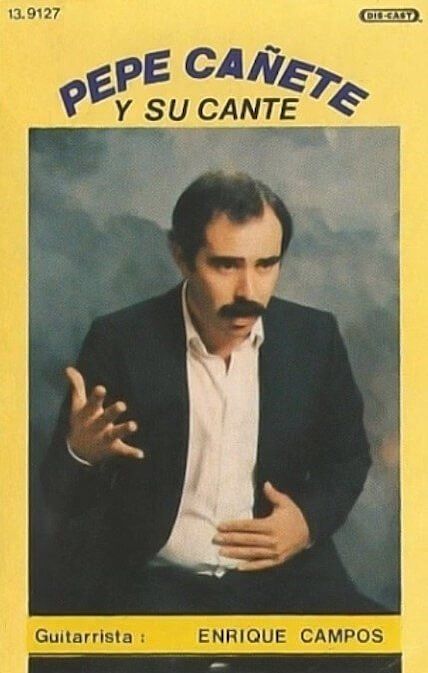
1982 album featuring Enrique Campos
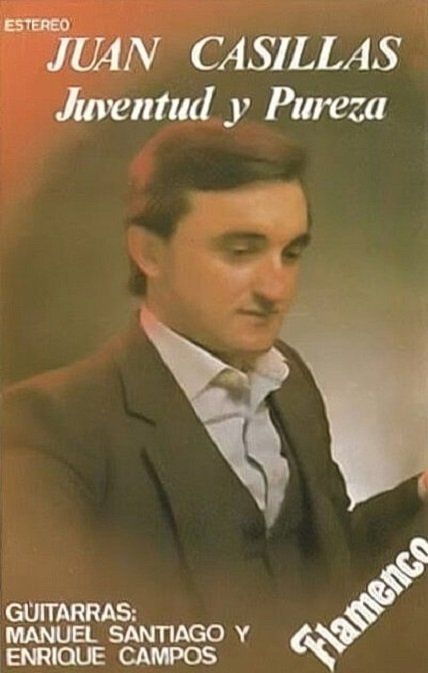
1984 album featuring Enrique Campos
Video of Enrique Campos accompanying Juan Casillas por seguiriya.
Probably the most lasting memory — musically speaking — I have of The Chandos is a rumba falseta/theme that Pepe used to play. I don't remember if it was his composition, but it always seemed as if it was his and I never heard it elsewhere. Much later in the late 1990s I would use it as the main theme in a homage composition which I called Chandos Medley, designed to conjure up memories of the place by way of melodies similar to the type that Pepe played/sang/accompanied (click video below left to hear the piece in a presentation from my Youtube channel).
More Coming Soon...
